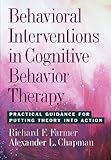Behavioral interventions in cognitive behavior therapy : practical guidance for putting theory into action / Richard F. Farmer, Alexander L. Chapman.
Material type: TextSeries: APA ebookPublication details: Washington, D.C. : American Psychological Association ; London : Eurospan [distributor], c2008.Edition: 1st edDescription: xiv, 341 p. ; 26 cmISBN:
TextSeries: APA ebookPublication details: Washington, D.C. : American Psychological Association ; London : Eurospan [distributor], c2008.Edition: 1st edDescription: xiv, 341 p. ; 26 cmISBN: - 9781433802416:
- 9781433802416 (print)
- 1433802414 (print)
- 616.89142
- F37 2008
IT Carlow ebook
Includes bibliographical references (p. 297-322) and index.
Overview -- Principles, goals, and structure of initial assessment sessions -- Behavioral case formulation -- Treatment planning -- Changing behavior by changing the environment -- Targeting the functional aspects of thoughts and thinking patterns -- Changing behavior by building skills -- Activating behavior: the example of depression -- Exposure-based interventions -- Acceptance- and mindfulness-based interventions -- Bringing therapy to a close and aftercare.
"Cognitive behavior therapy (CBT) dominates lists of evidence-based treatments and is increasingly used by front-line clinicians. Behavioral methods, such as self-monitoring, behavioral activation, behavioral experiments, exposure therapy, and skills training, are core features of CBT. In fact, some studies suggest that these are among the primary active ingredients in CBT. In this detailed, step-by-step guide, Richard F. Farmer and Alexander L. Chapman show readers how to put behavioral theory and science into action. They discuss case formulation and treatment planning, core behavioral intervention strategies, and innovative approaches, such as acceptance, mindfulness, and a behavioral approach to cognition. Flexible and useful across different client populations, the behavioral interventions described in this volume leave room for therapists to be respectful of their clients' unique needs and* individuality. Using case examples, the authors demonstrate how to generate case formulations, apply interventions, respond to common problems, navigate termination, and help clients to generalize treatment gains beyond therapy. The behavioral framework they describe is practical and accessible to clinicians and students with varying degrees of behavioral training"--Jacket. (PsycINFO Database Record (c) 2008 APA, all rights reserved).
Also issued in print.
Electronic reproduction. Washington, D.C. American Psychological Association 2005 Available via the World Wide Web Access limited by licensing agreement s2005 dcunns
